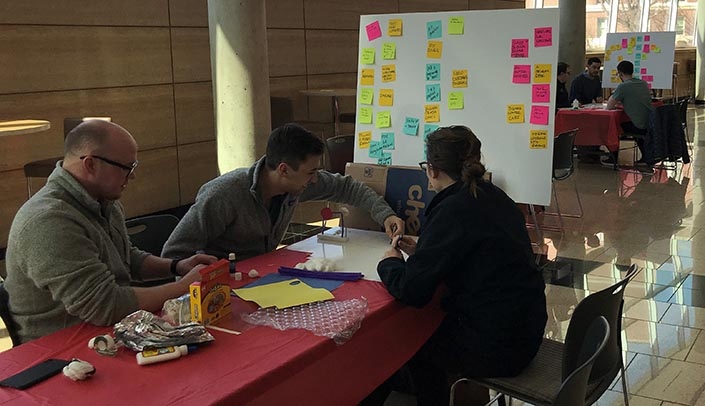UNMC Department of Emergency Medicine residents, staff, and fellows participated in a half-day workshop on March 21 in which they learned and applied principles of design thinking to innovation in emergency patient care.
The workshop was facilitated by emergency medicine faculty T. J. Welniak, M.D., associate residency program director, and Thang Nguyen, a doctoral candidate in innovation science who has helped spearhead the UNO-UNMC Idea Accelerator and multiple other medical innovation projects.
Popularized by IDEO and Stanford’s d.school, design thinking is a methodology for creative problem-solving centered on principles of empathy, collaboration and learning through experimentation.
It has been adapted by corporations such as IBM, General Electric, Apple, and Google to come up with innovative, human-centered solutions and products, including those in health care. In the last few years, it has gained traction as a major component of undergraduate medical training in institutions such as Sidney Kimmel Medical College in Philadelphia and Dell Medical School in Austin, Texas.
The workshop was open to colleagues in nursing, pharmacy, emergency medicine faculty, and residents to collaborate on coming up with novel means of improving the emergency department patient experience. At the start of the challenge, teams were each given a series of patient narratives and survey results in order to understand patient needs and define areas of opportunity to improve their experience. Once a problem was isolated, the teams were asked to brainstorm as many, out-of-the-box ideas as possible.
“By visualizing and testing your ideas early on using even the roughest of prototypes, you learn additional information about your idea that you may not have otherwise until much later in the process, saving you time, money, and headaches,” Dr. Welniak said.
Dr. Welniak and Nguyen see the concept as one of many available tools available for use in innovation and quality improvement, but appreciate the ease to which it can be taught and the fact that it prioritizes both designing for and learning from the end-user.
“At minimum, we hope this kick starts a mindset in our learners that they each have the capability to work collaboratively and creatively in tackling some of our toughest problems in health care,” they said.
The duo looks forward to expanding the pilot process to bring more learners and more experts from a variety of disciplines together to works towards meaningful, tangible solutions for the benefit of the university, the Omaha community, and beyond.
